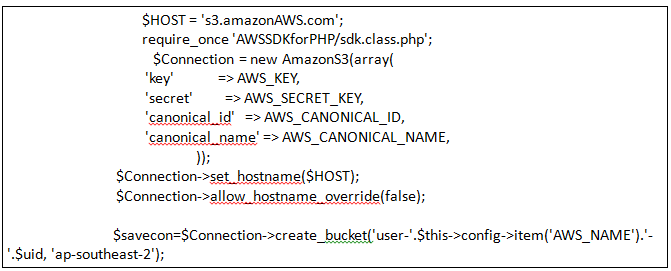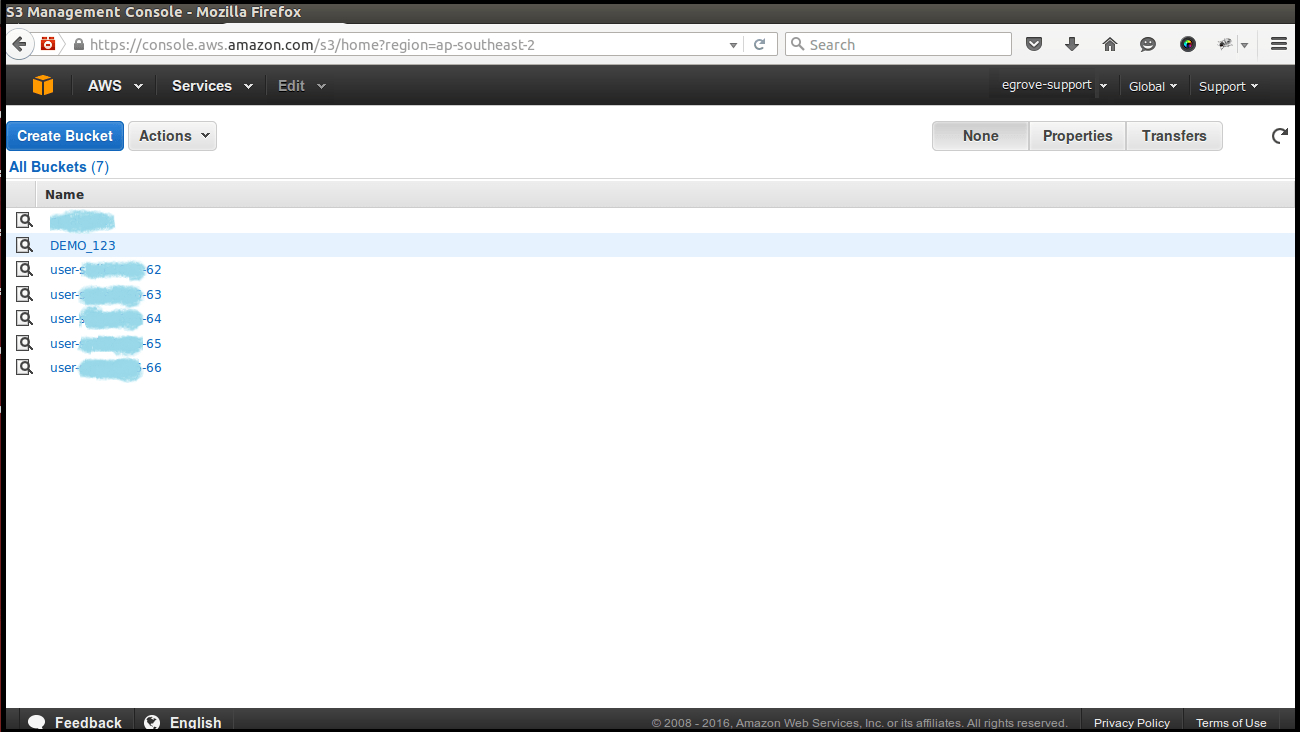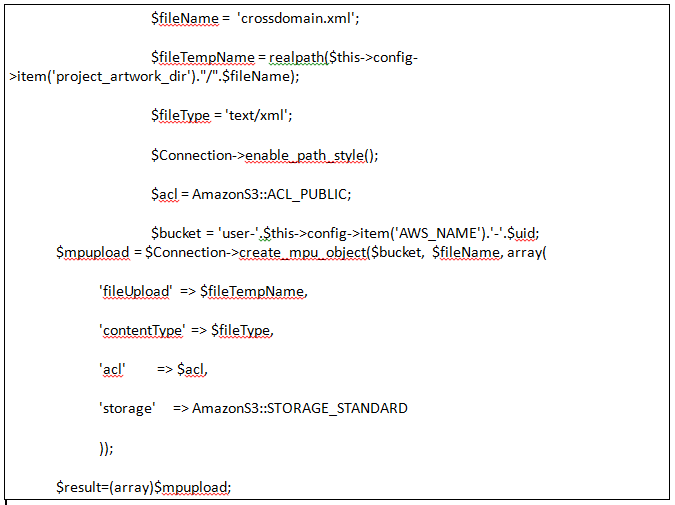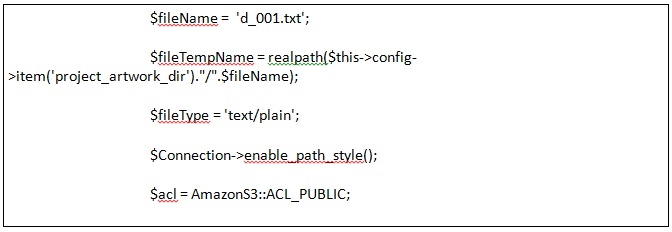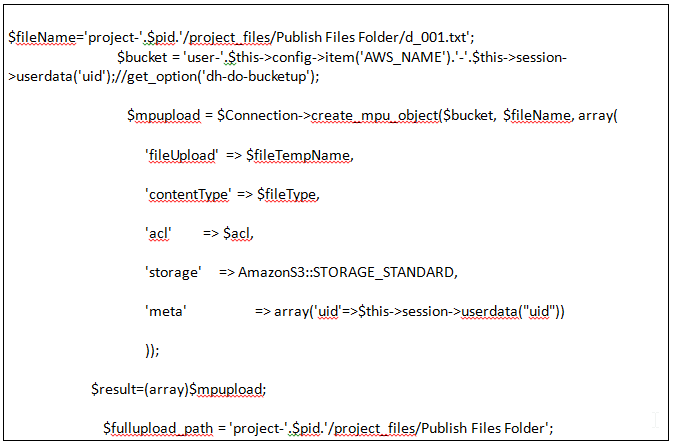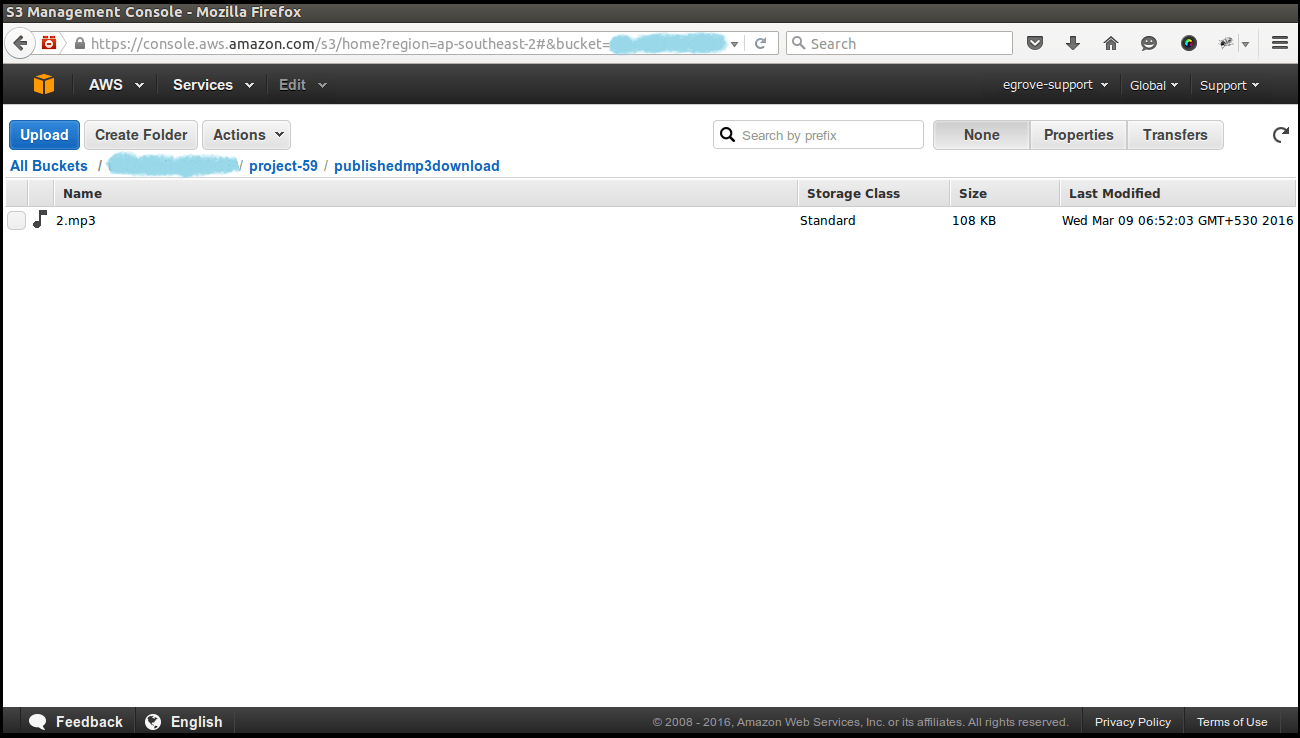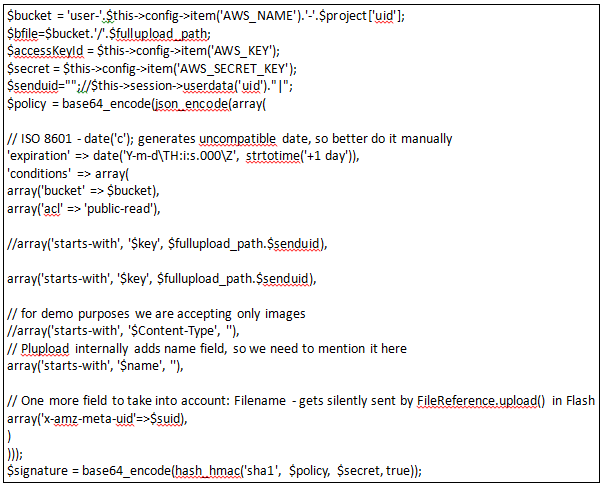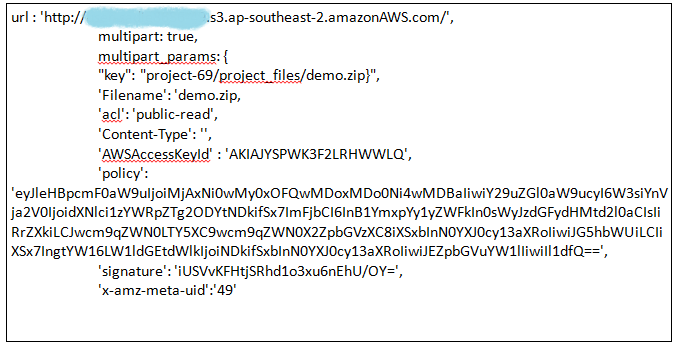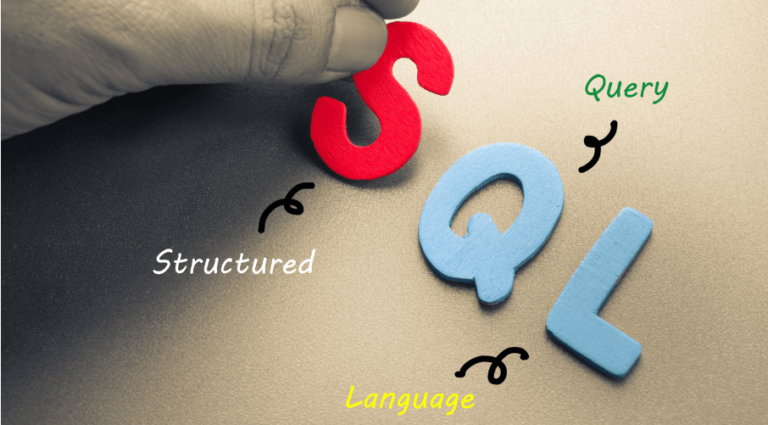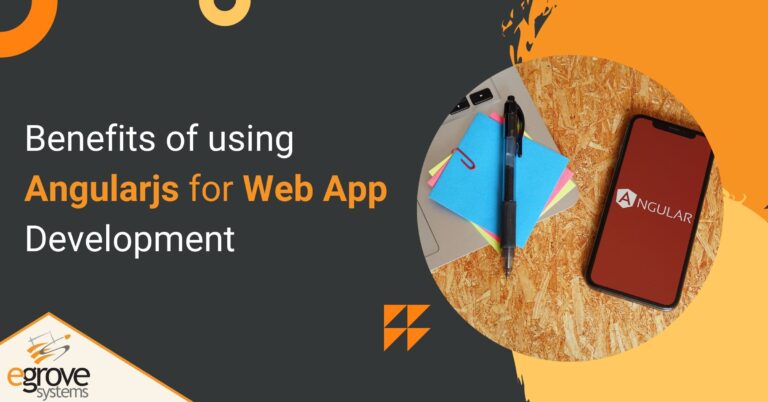Here are the steps need to be followed to synchronize the media files between web development and Amazon S3.
Step: 1 Allocate separate space in AWS
First we need to allocate separate space in AWS for each user who is registering in to the website. Initially we should get AWS credentials like key, canonical id, canonical name, secret, username etc. from AWS account.
Separate space for each user in AWS can be achieved by bucket configuration. Bucket name should be unique. If same bucket is already associated with any one of account in AWS then it will throw an exception. Here Bucket name is formed in terms of AWS username and with unique registration ID of customer.
For Integration of AWS kit available for PHP we can download and extract in root folders. Kit name AWSSDKforPHP
After Registration we will create bucket with registered id in AWS.
This will create unique bucket in AWS. Ap-southeast-2 specifies the region in which buckets needs to be accessed. While creating buckets, if region is empty then it will create 400 error and shows invalidlocationconstraint error.
CrossDomain.xml
Each bucket has separate crossdomain.xml this is used while uploading or downloads a file in AWS. Crossdomain is used for allowing access control.
<?xml version=”1.0″?>
<!DOCTYPE cross-domain-policy SYSTEM “https://www.macromedia.com/xml/dtds/cross-domain-policy.dtd”>
<cross-domain-policy>
<allow-access-from domain=”localhost” secure=”false” />
<allow-access-from domain=”*” secure=”false” />
<allow-http-request-headers-from domain=”*” headers=”*”/>
</cross-domain-policy>
Crossdomain can be accessed with its own bucket URL. Example https://xxxx-xxxxxx-xx.s3-ap-southeast-2.amazonAWS.com/crossdomain.xml
Bucketname: xxxx-xxxxxx-xx
Region: ap-southeast-2
Host: s3.amazon.com
Filename: crossdomain.xml
If we use this endpoint URL then files can be uploaded immediately after bucket creation. Suppose if we used only s3.amazon.com then for files upload it will be delayed for some 2 hours from the time of bucket creation.
Ex- https://xxxx-xxxxxx-xx.s3.amazonAWS.com/crossdomain.xml
Because by default AWS has redirection (307) for some time delay if we accessed host URL instead of region URL in file upload. So for better performance we should call the region endpoint URL.
The above code will upload crossdomain files in s3 bucket.
Folders in AWS s3
In each bucket we have create separate project for particular user. Separate folders are created for each project with its project id. Project folders are unique.
The above code will create project in each bucket with its project id. We can call these files similar to crossdomain.xml for example:
https://xxxx-xxxxxx-xx.s3-ap-southeast-2.amazonAWS.com/project-1/project_files/Publish Files Folder/d1.txt
Similarly we can save multiple folders in each bucket and can be downloaded with its unique access endpoint.
Login to AWS it will list out all the buckets available in your AWS account. Selects your particular bucket and click open and then to folders. In this image.
Allbuckets – List out all buckets
xxxx-xxxxxx-xx – Bucket Name
Project-59 – Project with its id ( To differentiate multiple projects is differentiated with its own project id)
In properties tab we can set a classes and other properties and click save.
Configuration for File Upload
The above code will be used for file upload will send to AWS with generated signature for AWS, Policy, acl access, bucket, and request id, file path etc
$(“#uploader2”).plupload({
buttons: {
browse: true,
start: false,
stop: false
},
runtimes : ‘flash’,//html5,silverlight
url : ‘https://<?php echo $bucket; ?>.s3-ap-southeast-2.amazonAWS.com/’,
multipart: true,
multipart_params: {
“key”: “<?php echo addslashes($fullupload_path).$senduid ?>${filename}”,
‘Filename’: ‘${filename}’, //adding this to keep consistency across the runtimes
‘acl’: ‘public-read’,
‘Content-Type’: ”,
‘AWSAccessKeyId’ : ‘<?php echo $accessKeyId; ?>’,
‘policy’: ‘<?php echo $policy; ?>’,
‘signature’: ‘<?php echo $signature; ?>’,
‘x-amz-meta-uid’:'<?php echo $this->session->userdata(‘uid’); ?>’
},
file_data_name: ‘file’,
filters : {
// Maximum file size
max_file_size : ‘5000mb’,
// Specify what files to browse for
mime_types: [
{title : “upload files”, extensions : “*”}
]
},
dragdrop: true,
autostart : true,
// Flash settings
flash_swf_url : ‘../../plupload/js/Moxie.swf’,
init:{
FileFiltered: function(up,file){
//console.log(file[‘name’]);
},
FileUploaded: function(up, file, info) {
//Allow Download Permisssion
var allow_download = $(“#”+file.id).find(“#allow_download_”+file.id).val();
var pid = $(“#filepid”).val();
var fileurl = $(“#fileurl”).val();
$(‘.loading-overlay’).addClass(“loading”);
$.ajax({
complete: function() {$(‘.loading-overlay’).removeClass(“loading”); }, //Hide spinner
url : ‘<?php echo base_url();?>project/fileuploadednotification’,
data:{allow_download:allow_download,filename:file[‘name’],filesize:file[‘size’],pid:pid,fileurl:fileurl},
type : “POST”,
dataType : ‘json’,
success : function(data) {
//alert(data.meta.code);
if(data.meta.code == “200”)
{
//alert(data.result);
}
},
beforeSend: function(XMLHttpRequest){}, //$.blockUI();
cache: false,
error : function(data) {
//alert(“error occur…”);
}
});}} });
The above code is used for file upload. Pulpupload is like a jQuery library and it is used to upload a file to AWS. It has special documentation for file uploading in AWS server.
The above code will check for crossdomain access in AWS bucket will make a request to url ( https://xxx-xxxxx-xx.s3-ap-southeast-2.amazonAWS.com/crossdomain.xml ) once it got success 200 request it will allow you to upload a file.
Else it shows http error and not allows uploading a file. Endpoint URL will be more specific and related to particular bucket like
https://<?php echo $bucket; ?>.s3-ap-southeast-2.amazonAWS.com/’,
Here ap-southeast-2 will be your region; you should change according to your region id. For region and its specific endpoint URL refer AWS documentation.
Here I will attach Request and Response for Bucket Creation and Crossdomain.xml and file upload.
Bucket Creation Request
[header] => Array
(
[x-amz-id-2] => 0zT0sOYzXwCvmCI5rxSu7h1+6qOAtwQht6D+pMukpO7cqoMkqCkfG35n7yXNet28Ci0Eu443JeQ=
[x-amz-request-id] => 7AC02DDB266E3290
[date] => Thu, 17 Mar 2016 04:02:28 GMT
[location] => https://xxx-xxxxx-xx.s3.amazonAWS.com/
[content-length] => 0
[server] => AmazonS3
[_info] => Array
(
[url] => https://xxx-xxxxx-xx.s3.amazonAWS.com/
[content_type] =>
[http_code] => 200
[header_size] => 273
[request_size] => 655
[filetime] => -1
[ssl_verify_result] => 0
[redirect_count] => 0
[total_time] => 0.599251
[namelookup_time] => 0.082067
[connect_time] => 0.089523
[pretransfer_time] => 0.111582
[size_upload] => 198
[size_download] => 0
[speed_download] => 0
[speed_upload] => 330
[download_content_length] => 0
[upload_content_length] => 198
[starttransfer_time] => 0.599165
[redirect_time] => 0
[certinfo] => Array
(
)
[redirect_url] =>
[method] => PUT
)
[x-AWS-request-url] => https://xxx-xxxxx-xx.s3.amazonAWS.com/
[x-AWS-redirects] => 0
[x-AWS-stringtosign] => PUT
Ixgb0XZlX2l05jyO8O+KpA==
application/xml
Thu, 17 Mar 2016 04:02:26 GMT
x-amz-acl:private
/xxx-xxxxx-xx/
[x-AWS-requestheaders] => Array
(
[Content-MD5] => Ixgb0XZlX2l05jyO8O+KpA==
[Content-Type] => application/xml
[Date] => Thu, 17 Mar 2016 04:02:26 GMT
[x-amz-acl] => private
[Authorization] => AWS AKIAJYSPWK3F2LRHWWLQ:vreNHsuO/zTe5n1elvofBPvczKI=
[Expect] =>
)
[x-AWS-requestbody] => <?xml version=”1.0″ encoding=”UTF-8″?>
<CreateBucketConfiguration xmlns=”https://s3.amazonAWS.com/doc/2006-03-01/”><LocationConstraint>ap-southeast-2</LocationConstraint></CreateBucketConfiguration>
)
[body] =>
[status] => 200
)
CrossDomain.xml Request
Array
(
[header] => Array
(
[x-amz-id-2] => Gsr9d1MFGenGZJA7nMjd089bhg44WNmwmcO3DAVBHG8mNvV1tX0OEkUMFhLkzGaqNpV3QcTtBcQ=
[x-amz-request-id] => 28278A5FEAEB0745
[date] => Thu, 17 Mar 2016 04:02:29 GMT
[etag] => “f488f4dc371f9b58dd002da16a1b1c42”
[content-length] => 0
[server] => AmazonS3
[_info] => Array
(
[url] => https://xxx-xxxxx-xx.s3-ap-southeast-2.amazonAWS.com/crossdomain.xml
[content_type] => application/xml
[http_code] => 200
[header_size] => 665
[request_size] => 1011
[filetime] => -1
[ssl_verify_result] => 0
[redirect_count] => 1
[total_time] => 1.289578
[namelookup_time] => 0.114481
[connect_time] => 0.331342
[pretransfer_time] => 0.771969
[size_upload] => 327
[size_download] => 0
[speed_download] => 0
[speed_upload] => 253
[download_content_length] => 0
[upload_content_length] => 327
[starttransfer_time] => 1.010364
[redirect_time] => 0.038524
[certinfo] => Array
(
)
[redirect_url] =>
[method] => PUT
)
[x-AWS-request-url] => https://xxx-xxxxx-xx.s3.amazonAWS.com/crossdomain.xml
[x-AWS-redirects] => 0
[x-AWS-stringtosign] => PUT
text/xml
Thu, 17 Mar 2016 04:02:27 GMT
x-amz-acl:public-read
x-amz-storage-class:STANDARD
/xxx-xxxxx-xx/crossdomain.xml
[x-AWS-requestheaders] => Array
(
[Content-Type] => text/xml
[Date] => Thu, 17 Mar 2016 04:02:27 GMT
[Expect] => 100-continue
[x-amz-acl] => public-read
[x-amz-storage-class] => STANDARD
[Authorization] => AWS AKIAJYSPWK3F2LRHWWLQ:0njsfWoJaN0hOpg7DuK0HCLP8lg=
)
)
[body] =>
[status] => 200
)
File Upload
Bucket Deletion:
Similarly, we can delete the bucket programmatically in AWS by calling delete_bucket(bucketname). Once bucket is deleted we can again create bucket with same name; in same regions without any exceptions.



